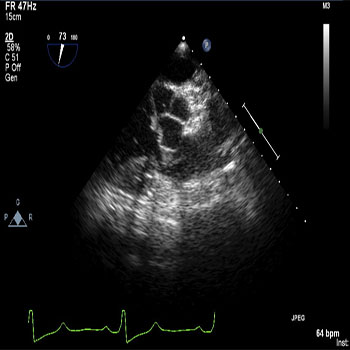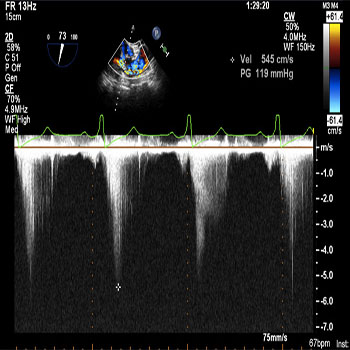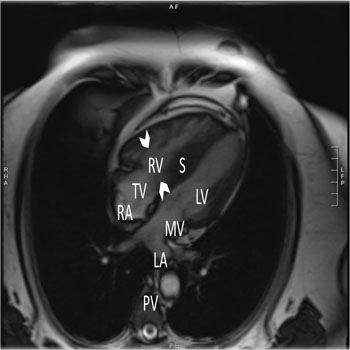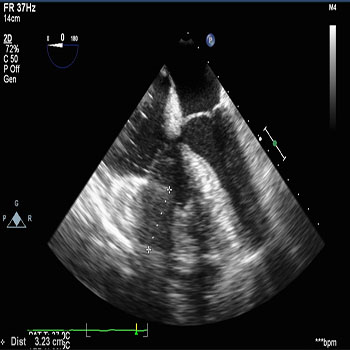Previous Issues Volume 1, Issue 1 - 2017
A Case of Adult Double-Chambered Right Ventricle Causing Severe Right Ventricular Outflow Tract Obstruction: A Perioperative Perspective
Blake S. Watterworth1*, Wendy K. Bernstein2, Inna Shats3
1Department of Anesthesiology, University of Maryland School of Medicine, 22 South Greene Street, Baltimore, MD 21201, USA.
2Associate Professor, Department of Anesthesiology, University of Maryland School of Medicine S11 C 22 S Greene Street, Baltimore, Maryland 21201, USA.
3Chief Intraoperative Cardiac Sonographer22 South Greene Street, Baltimore, MD 21201, USA.
Corresponding Author:Blake S. Watterworth, Department of Anesthesiology, University of Maryland School of Medicine, 22 South Greene Street, Baltimore, MD 21201, USA,Tel: +1 (401) 328-1239; Email: [email protected]
Received Date: 23 Mar 2016
Accepted Date: 03 May 2016
Published Date: 20 May 2016
Copyright © 2016 Watterworth BS
Citation: Watterworth BS, Bernstein WK and Shats I. (2016). A Case of Adult Double-Chambered Right Ventricle Causing Severe Right Ventricular Outflow Tract Obstruction: A Perioperative Perspective. Mathews J Surgery. 1(1): 001.
KEYWORDS
Double chambered right ventricle; Adult congenital heart defect; Ventricular outflow obstruction; Ventricular outflow obstruction diagnosis; Pulmonary hypertension.
INTRODUCTION
Double-chambered right ventricle (DCRV) is a rare, congenital heart disease often caused by anomalous muscle bands that can obstruct or even divide the right ventricle into high and low pressure chambers leading to progressive right ventricular outflow (RVOT) obstruction. It is seen in only 0.5-2% of all congenital heart diseases and associated with VSD in 75-90% of cases [1-3]. DCRV is typically diagnosed and treated during childhood, with rare diagnoses made in adulthood [1, 4-14]. There does not appear to be a genetic component [2]. It can be difficult to diagnose, especially in the adult patient, due to limitations in modern imaging of the right ventricle [4]. We report a case of a 63-year-old female who returned to the United States for the first time since diagnosis of ventricular septal defect (VSD) at age three. Her symptoms of dyspnea on exertion and fatigue were attributed to right ventricular hypertrophy with obstruction. The patient was scheduled for VSD closure and myomectomy of RVOT utilizing cardiopulmonary bypass (CPB). The severe nature of her disease required careful planning of her perioperative management to maintain stable hemodynamics and prevent cardiovascular collapse. Intra-operatively the patient was found to have a myocardial morphology consistent with DCRV. Successful selection and timing of anesthetics, invasive monitoring, vasopressors, and inotropes facilitated an uneventful hospital course. Discharge occurred on post-operative day four without adverse sequelae. While previous reports have focused on the surgical findings and procedures, very few case reports in the literature have concentrated on the anesthetic management of this complicated congenital condition. This is the only known case that did not require a significant fluid load following induction and initiation of positive pressure ventilation [15]. With careful planning it was even possible to remove autologous blood to minimize transfusion requirements. This report will aid the perioperative team in recognition of characteristic findings in DCRV and offer insight into perioperative management.
CASE REPORT
The patient is a 63-year-old female with a known history of uncorrected, congenital VSD who returned to the United States for evaluation of increasing shortness of breath during light activity. Her parents, both missionaries in Tanzania, brought the patient to the U.S. at age three for evaluation of a murmur noted at birth. At the time, it was deemed unnecessary to intervene, and the patient experienced a largely unrestricted life in Africa completing missionary work herself. Over the last few years the patient noted a few episodes of atypical non-exertional chest pain as well as progressive exertional dyspnea. The patient's medical history included only known congenital VSD and right ventricular hypertrophy. She had not undergone prior surgeries. She did not use tobacco, alcohol or illicit drugs and her family history includes heart failure and stroke. The patient underwent extensive cardiac evaluation upon returning to the United States including transthoracic echocardiography (TTE), transesophageal echocardiography (TEE), cardiac magnetic resonance imaging (MRI), right and left heart catheterization with ventriculography, as well as electrocardiogram (ECG). The patient was noted to have severe narrowing of the RVOT (Figure 1) with severely increased velocity of 5.45 m/sec and severe pressure gradient of 119 mm Hg across the tract (Figure 2).
Figure 1: Preoperative transesophageal echocardiogram. Midesophageal right ventricular inflow/outflow view (73°) shows severe narrowing of the right ventricular outflow tract proximal to the pulmonary valve consistent with infundibular stenosis. RV: right ventricle, AV: aortic valve, LA: left atrium, RVOT: right ventricular outflow tract, PT: pulmonic trunk.
Figure 2: Preoperative transesophageal echocardiogram. Midesophageal right ventricular inflow/outflow view (73°)with continuous wave Doppler of the right ventricular outflow tract shows velocity across the infundibular stenosis measuring 5.45 m/sec. Peak gradient is 119 mm Hg across the outflow tract. Color-coded flow Doppler imaging shows turbulent flow within the right ventricle and outflow tract.
Also present was severe right ventricular dilatation with mild tricuspid, mitral, and aortic regurgitation. A noted perimembranous ventriculoseptal defect below the aortic valve was noted. There are heavy trabeculations noted in the RV with moderate hypertrophy seen on cardiac MRI (Figure 3).
Figure 3: Preoperative cardiac magnetic resonance imaging Horizontal long axis, four chamber view shows heavy trabeculations of the right ventricle with mild-to-moderate hypertrophy. Anomalous muscle bands can be seen dividing the right ventricle causing obstruction (arrowheads). RV: right ventricle, TV: tricuspid valve, RA: right atrium, S: septal thickening with trabeculations, LV: left ventricle, MV: mitral valve, LA: left atrium, PV: pulmonary vein.
Preoperative cardiac catheterization measured mean right atrial pressure at 7 mm Hg with RV pressure of 169/6 mm Hg and PA pressure of 63/7 mm Hg with mean 26 mm Hg. An ECG showed sinus rhythm with right axis deviation and significant right ventricular hypertrophy with strain pattern. The patient was scheduled for VSD closure and myomectomy of RVOT with midline sternotomy and cardiopulmonary bypass. Preoperatively, the patient was in sinus rhythm with a blood pressure of 131/80 mm Hg. Anxiolysis was avoided to minimize respiratory depression and hypercapneic exacerbation of pulmonary hypertension. Intra-operatively, standard lines were placed consisting of multi-lumen access catheter and pre-induction radial arterial line. Induction proceeded with careful attention to hemodynamics to avoid collapse secondary to RVOT obstruction. An adequate initial hemoglobin of 14.4 g/dL allowed for autologous blood removal totaling of 450cc. The patient did not require inotropes prior to initiation of CPB. Intraoperative TEE revealed left ventricular ejection fraction (LVEF) of 55%. There is notable thickening of the RV wall contributing to RVOT obstruction (Figure 4).
Figure 4: Intraoperative transesophageal echocardiography. Midesophageal four chamber view (0°) reveals right ventricular wall thickening to 3.23 cm indicating anomalous muscle bundles contributing to right ventricular outflow tract obstruction. RA: right atrium, TV: tricuspid valve, RVW: right ventricular wall, RV: right ventricle, LA: left atrium, MV: mitral valve, LV: left ventricle.
Midline incision and sternotomy were performed. Cardiopulmonary bypass was initiated via cannulae placed into the ascending aorta and right atrium. Upon direct visualization of the right ventricle via ventriculotomy, it was noted to be double- chambered. Myomectomy of the RVOT was performed and primary closure of the VSD was performed. Prior to weaning from CPB, a pulmonary artery catheter was manually inserted into the pulmonary artery and secured. CPB time was seventy-one minutes. Weaning from CPB required milrinone and vasopressin infusions given mild RV strain as well as elevated pulmonary artery pressure of 43/16 mm Hg. The patient was transfused with 2 units of packed red blood cells, 500ml of cell saver blood and return of autologous blood to achieve a hemoglobin of 9.3 g/dL. The patient did not immediately regain sinus rhythm and required pacing via temporary ventricular wires. The patient was extubated on post-operative day one. She was transferred to the cardiac step-down unit then discharged on post-operative day four. The post-operative TTE showed grossly normal left and right ventricular function without evidence of increased gradients across the RVOT. During follow-up, the patient was without symptoms, and was able to return to Africa six weeks later.
DISCUSSION
DCRV was first described in 1867 by Peacock, however consideration of the abnormality to be a separate congenital entity occurred in the early 1960's with the first surgical correction performed by Lucas et al. in 1962 [3, 16]. The definition and diagnostic criteria vary as multiple morphologies of anomalous muscle bundles have been described. There have been reports of up to seven different variants and these are typically divided into those containing anomalous muscle bundles crossing the RV, or they involve hypertrophy of trabecular structures without muscle bundles, termed Type 1 or Type 2 DCRV, respectively [3, 9]. Diagnostic criteria for DCRV can be broad, but the following diagnostic criteria were used by Lascano et. al. [4].
-
Midcavity obstruction by TTE or TEE and an intra-ventricular pressure gradient by Doppler findings.
-
Demonstration of a systolic pressure gradient between the right ventricular inflow and outflow tracts during cardiac catheterization and/or visualization of high or low anomalous muscle bundles below the infundibulum on angiocardiography.
-
Absence of pulmonary hyperplasia.
-
Direct observation of the muscle bundles during surgical repair.
A positive diagnosis must include two of the first three criteria, and the fourth criterion is required in all cases. Various forms of imaging can be used to diagnosis doublechambered right ventricle including TTE, TEE, MRI, ECG, and catheterization. The most common findings of each study technique with advantages and disadvantage are found in Table 1.
Table 1: Common diagnostic features of double-chambered right ventricle with modern imaging modalities..
|
Transthoracic Echocardiography |
Cardiac MRI |
|---|---|
|
|
|
ADVANTAGE:
|
ADVANTAGE:
|
|
Transesophageal Echocardiography |
Heart Catheterization, Ventriculography |
|
|
|
ADVANTAGE:
|
ADVANTAGE:
|
|
Electrocardiogram: Right ventricular hypertrophy, right axis deviation, prominent R waves in the right precordial leads, absence of S waves in the left precordial leads. |
|
|
ADVANTAGE:
|
|
LVEDP: left ventricular end diastolic pressure, LVEF: left ventricular ejection fraction, MRI: magnetic resonance imaging, PA: pulmonary artery, RV: right ventricle, RVH: right ventricular hypertrophy, RVOT: right ventricular outflow tract, TEE: transesophageal echocardiography, TTE: transthoracic echocardiography
The most effective form of diagnosis was considered to be TEE, yet this modality can still miss the diagnosis [1, 4]. MRI may now be the most useful diagnostic tool [2, 6, 13]. In the case presented, the underlying pathology was apparent, however, a definitive diagnosis of DCRV was not made until direct surgical observation which is consistent with the difficulties in diagnosing this condition. The defect may be difficult to visualize on echocardiography per several case series and is diagnosed preoperatively by TTE in only 14.2% to 26% of patients [1, 4, 7]. This is due to limitations in TTE to adequately visualize the RV given its retrosternal location, irregular shape, and direction of flow accelerations. Case series have shown unexpected intraoperative diagnosis by direct visualization of DCRV in up to 11.5% of cases [1]. Surgical indications for treatment include a pressure gradient greater than 40-50 mm Hg across the pulmonary valve, a pulmonary-to-systemic blood flow ratio > 2.0, aortic regurgitation, or symptoms of heart failure [2, 3, 6, 8]. In those not receiving surgery, it has been observed that the mid-ventricular gradient increases an averages of 6.2 mm Hg per year [17]. Patients with repair of DCRV tend to have good outcomes with survival at 10 years approaching 90% without residual RVOT obstruction [7, 8].
PERIOPERATIVE CONSIDERATIONS
The diagnosis of DCRV may be difficult and physiologic parameters should be available which stratify gross abnormalities in heart structure and function. Patient history and exam will be important to qualify functional capacity and cardiopulmonary reserve which is often poor in these patients. Most commonly patients report dyspnea on exertion and decreased exercise tolerance [8]. Patients with DCRV have been primarily described within cardiothoracic surgical literature in several case series and case reports. While surgical technique and considerations are described in detail, prior reports do not discuss anesthetic implications for management. Our anesthetic plan takes into account several physiologic morbidities in patients with DCRV. A full anesthetic plan must be developed for the preoperative, intraoperative, and postoperative period to reduce risk of adverse event. Comorbidities often plaguing the patient will include pulmonary arterial hypertension (PAH) which is further complicated by RVOT obstruction. PAH places the patient at increased risk of perioperative morbidity and mortality [18]. Goals in the patient with PAH would include oxygen supplementation to minimize the rise in pulmonary vascular resistance (PVR) so that oxygen saturation is maintained and hypercapnia is avoided [19]. Treatment of PAH may be required intra-operatively to avoid failure in an already strained RV. The phosphodiesterase- 3 enzyme inhibitor, milrinone, was used to reduce pulmonary vascular resistance as well as provide inotropic support post-cardiopulmonary bypass. We also had nitric oxide on standby if required. Other treatment options include the use of prostacyclin analogues, calcium channel blockers, or endothelin receptor blockers. Dobutamine has also been used post-cardiopulmonary bypass [20]. The pharmacokinetics, cost, and need for multiple therapies must be considered when adding a second agent. Given the severity of RV obstruction, preload and afterload must be maintained for adequate cardiac performance and perfusion since hypovolemia in the patient could be catastrophic. An assessment of volume status preoperatively may indicate a need for either volume resuscitation or diuretic use to prevent right ventricular failure. Multiple monitoring devices should be used in these patients based on the severity of disease. Thorough evaluation of heart function is essential requiring use of arterial catheter, pulmonary artery catheter, central venous pressure monitor, and TEE. Postoperatively, close monitoring must continue in the intensive care unit. Attention must be given to respiratory status and hemodynamic parameters. After DCRV repair there has been shown to be increased incidence of right bundle branch block postoperatively, at times requiring pacing [3, 9]. Intraoperative pharmacologic support should be carefully weaned, with additional treatment readily available. As stated previously, the outcome of DCRV repair is excellent, and patients typically do not have recurrence of symptoms [7, 8].
CONCLUSION
We have described a unique case of DCRV causing RVOT obstruction in an adult patient. The evaluation of such condition often requires multiple modalities of imaging, and may still require surgical exposure for definitive diagnosis as in this case. The anesthetic considerations for this condition are numerous and require a detailed assessment of patient symptoms and physiologic workup to anticipate the severity of the disease. Furthermore, careful anesthetic management is required for a successful perioperative outcome and minimization of adverse events.
REFERENCES
-
Nakata T, Hattori A and Kazuaki S. (2004). Double chambered right ventricle. Lancet. 363, 1137.



